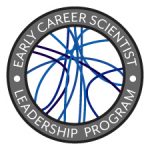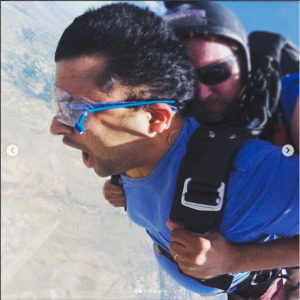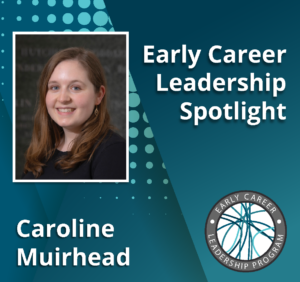 Asav Dharia works as a Competitive Talent Strategist and Research Analyst at Flagship Pioneering, matching leading scientists with newly forming companies and technologies. He’s centered his career on finding the big picture in science and looking for a niche where being a scientist becomes the value-add.
Asav Dharia works as a Competitive Talent Strategist and Research Analyst at Flagship Pioneering, matching leading scientists with newly forming companies and technologies. He’s centered his career on finding the big picture in science and looking for a niche where being a scientist becomes the value-add.
In the Decoding Life series, we talk to geneticists with diverse career paths, tracing the many directions possible after research training. This series is brought to you by the GSA Early Career Scientist Career Development Subcommittee.
Although Asav loved research during his PhD, he was always interested in a big-picture question: how does the research done every day in the lab change the world? During graduate school, he helped start a company called Smpl Bio that created software to simplify the design and analysis of targeted genetic tests; after, he sought opportunities where he could both explore his career options and take a high-level view of the biopharma industry. Then, he consulted for LifeSci Advisors to wade into market research before joining The Stevenson Group as a Research Associate and Consultant. In his current role as a Competitive Talent Strategist at the life science innovation enterprise Flagship Pioneering, he helps place top scientists and executives in leadership roles to build culture and drive innovation.
How did you find your first position after graduate school?

Asav Dharia.
While wrapping up my PhD in Genetics and Genomics from the University of Connecticut, I was consulting with Smpl Bio and looking for other opportunities where I could bridge science and business. On LinkedIn, I noticed an Equity Research Analyst at LifeSci Advisors who had a PhD, and I wrote him a short note, thinking he might have had similar interests. I explained that I was curious to explore the life science market and wanted to know what he does during his day-to-day at the office to see if there were any potential opportunities. Luckily for me, he had a lot going on at work, and he offered to give me a small project researching a company he was evaluating with the idea that, based on that project, I could work for him on a consulting basis. So that’s exactly what I did.
While I was working on the project at LifeSci Advisors, I continued exploring other opportunities to give me a broader idea of what the biopharma industry looks like. I was researching early stage companies and found myself wondering why someone would leave a comfortable job at a big pharmaceutical company to go work for a biotech startup that only had a little bit of data. It was then that I ran into Adam Bloom, CEO of life science executive recruiting firm The Stevenson Group; my conversation with him really impacted me. He explained that my scientific experience could lend to a career in executive recruiting: I could have informed conversations with the leaders of biotech and pharma industries and place candidates in roles that needed experienced scientific leadership. That conversation led me to believe I should take the calculated risk of pursuing a non-traditional career in executive search and joined The Stevenson Group.
What did you do in graduate school that prepared you for that jump to business?
During my PhD, I actually co-founded a small biotech company, Smpl Bio. It was a result of participating in the UConn Innovation Quest inQbator, where students pitch ideas to venture capitalists in the UConn alumni community to get funding. I contributed to the pitch, business development, market research, and competitive intelligence work while others on my team did the scientific work.
I was also involved with the Tufts consulting club. At a networking event, I met the club leader, who told me there were a couple of PhD students and postdocs at Tufts trying to get into consulting. I just said, “Hey, I’m interested in knowing more about this,” and they invited me to a consulting competition at Yale. That competition was open to everybody, and even though we knew it wasn’t going to be centered on a biotech project, we were excited about the opportunity to get exposure on how a consulting position would work.
Additionally, I attended many conferences and forums to network with professionals in pharma and biotech.
Who guided you in making the switch to a business heavy career?

Asav Dharia skydiving.
Most recently, my current supervisor Grace Niwa, VP of Talent Acquisition at Flagship Pioneering, is playing an instrumental role in guiding me through the world of venture-backed companies. Additionally, Adam Bloom, who I spoke about earlier, has been super supportive. Even though I was leaving his company, he was instrumental in making sure that I was wise about that career move. He gave me some crucial pointers that really helped me succeed.
However, a lot of the credit has to go to my mentor David Weisman, who I met during my undergraduate years at UMass. After co-founding a successful consulting business focused on system software design for years, he had returned to academia to apply his skills to the field of molecular and cellular biology. While I was considering each crucial career decision that I’ve made—including my first job as a Research Assistant and Lab Administrator at Tufts-NEMC, joining a PhD program, and consequently becoming an executive search consultant—David was the one who asked me the tough questions and gave me the right guidance.
What did you do as an executive search consultant for The Stevenson Group?
My role at The Stevenson Group was to be the scientific face of the company with regards to providing market research, delivering competitive intelligence and connecting with industry leaders. My responsibilities included mapping the industry—what companies work in the space, who are the potential candidates, where do they work—and to present that to senior management clients across pharma, biotech, medical device, and diagnostics. Through conversations with company leadership, I figured out where the gaps were in the team, be it early discovery or clinical development. I highlighted the skills and work the candidate had done to make the connection between candidate and company. For example, if a company was trying to fill a position for a scientist that works on a very specific rare disease, I targeted someone who had worked on that specific genetic disorder. By utilizing my scientific expertise and background in genetics, I immediately added value to the role when it came to understanding the technology developed by small biotechs and their scientific needs.
How did you pitch yourself when you moved to your current position at Flagship Pioneering?
 I was aware that Flagship Pioneering was a scientifically-rich and entrepreneurial environment with brilliant minds creating and building life sciences companies that invent breakthrough technologies. I knew a big part of my job would be to help them find top-tier scientific talent that would continue to help build Flagship’s ecosystem and portfolio companies. At The Stevenson Group, I was the only team member with a PhD; Flagship Pioneering, however, is a company where the majority of people have PhDs. The value I was bringing was the experience I had gained understanding the market trends and landscape from a talent perspective. Flagship Pioneering has many PhDs working on interesting projects in their different companies, but what they didn’t have when I came on board was a PhD on the talent acquisition side who could speak to scientists and C-suite level pharma and biotech individuals from a talent perspective. Hence, my goal was to come in and immediately add value by bringing the right talent to the right companies within Flagship Pioneering’s portfolio.
I was aware that Flagship Pioneering was a scientifically-rich and entrepreneurial environment with brilliant minds creating and building life sciences companies that invent breakthrough technologies. I knew a big part of my job would be to help them find top-tier scientific talent that would continue to help build Flagship’s ecosystem and portfolio companies. At The Stevenson Group, I was the only team member with a PhD; Flagship Pioneering, however, is a company where the majority of people have PhDs. The value I was bringing was the experience I had gained understanding the market trends and landscape from a talent perspective. Flagship Pioneering has many PhDs working on interesting projects in their different companies, but what they didn’t have when I came on board was a PhD on the talent acquisition side who could speak to scientists and C-suite level pharma and biotech individuals from a talent perspective. Hence, my goal was to come in and immediately add value by bringing the right talent to the right companies within Flagship Pioneering’s portfolio.
What are your key considerations when negotiating for a new position?
When you change positions, you may take a short term pay cut in exchange for higher returns later—but you want to be aware of your big picture goal. When I negotiate, I’m not just concerned with the salary, I’m also looking at equity-based incentives, stock options, opportunities to continue learning by taking courses and attending conferences, work-from-home capabilities, paid time-off (to maintain work-life balance) and mid-year bonuses. I would encourage anyone to consider all aspects of compensation when negotiating.
About the author:
 Tony Patelunas is a liaison on the Early Career Scientist Career Development Committee and a PhD Candidate in the department of Molecular and Cell Biology at the University of Connecticut. He strives to build a community of scientists that transcends industries and brings data-driven decision making to policy.
Tony Patelunas is a liaison on the Early Career Scientist Career Development Committee and a PhD Candidate in the department of Molecular and Cell Biology at the University of Connecticut. He strives to build a community of scientists that transcends industries and brings data-driven decision making to policy.
Learn more about the GSA’s Early Career Scientist Leadership Program.














